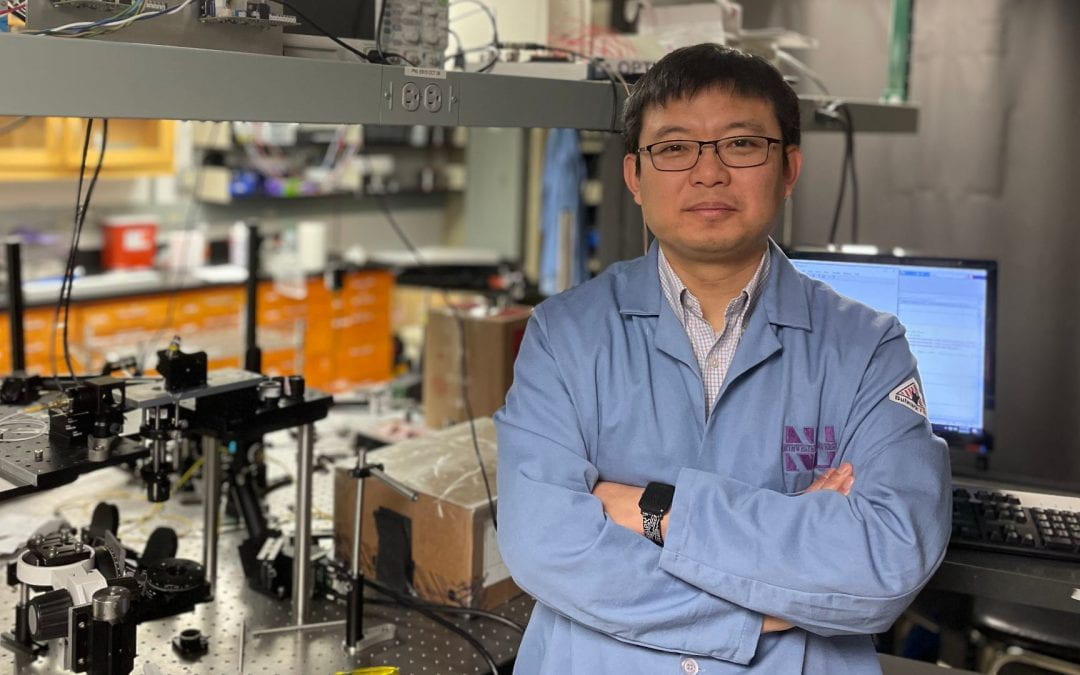In the world of optical imaging, Chemistry of Life Processes Institute member Hao F. Zhang, PhD, Professor of Biomedical Engineering at Northwestern University, is at the top of his game. His groundbreaking work and research collaborations have pushed the limits of multi-scale imaging and ushered in new investigative and therapeutic approaches for blinding diseases, such as diabetic retinopathy, glaucoma, and age-related macular degeneration.
Zhang’s studies often grace the covers of industry publications, break records for the number of downloads, and have attracted more than $25 million in research funding. His honors include the NSF CAREER award and NIH Director’s Challenge Award in 2010, the NIH IMPACT award in 2015, the SPIE Translational Research Award in 2016, and the US National Academy of Sciences Cozzarelli Prize in 2017.
“When it comes to blue-sky innovation and collaboration, Hao is a master,” says Sheila Judge, Senior Director for Research, Education and Administration, Chemistry of Life Processes Institute. “His technologies and methods have opened up research and have made an extraordinary impact across many areas of biomedical research.”
The CLP Factor
Zhang joined Northwestern in 2011 as an assistant professor of biomedical engineering. Soon thereafter, he became a member of CLP.
“A major reason that I liked CLP from the beginning, and what sets it apart, is the efficiency of the staff and support team,” says Zhang. “If I need to write a large-scale multi-institutional grant, they are my resource. I have people to rely on. That peace of mind is very important.”
Zhang’s research lab, the Functional Optical Imaging Laboratory (FOIL) at Northwestern, focuses on improving two powerful optical imaging technologies: the larger-scale optical coherence tomography (OCT) and the nanoscale single-molecule localization microscopy.
Major Breakthroughs
One of Zhang’s lab’s major research achievements is the development of visible-light optical coherence tomography (vis-OCT), which brings unprecedented anatomical and functional imaging capabilities to both pre-clinical research and potential clinical care.
“Behind the scenes, there are so many technical hurdles that we need to overcome, how to design a system, how to detect a signal, how to analyze the signal,” says Zhang. “By simply moving the illumination wavelengths from near-infrared light to shorter visible light wavelengths, we actually opened up the window to see a lot more information.
Vis-OCT’s ultra-high resolution images of active processes in living cells open up new frontiers in understanding the progression and management of blinding diseases, such as diabetic retinopathy and glaucoma. Recent refinements include detection of oxygenation levels and early formation of new blood vessels in the eye. These advances arm physicians with the ability to detect and treat problems before permanent damage occurs. Additional enhancements are poised to further understanding the epigenetics of cancer and, potentially, other diseases.
To make the vis-OCT technology more widely available to clinicians, Zhang and CLP member Cheng Sun partnered with Kieren Patel to launch Opticent Health based in Evanston, IL.
“The company currently has two product lines,” says Zhang. “One is tailored specifically for CROs [contract research organizations] and research labs. The other product is tailored to clinical research, as well as clinics, once FDA approval is granted.”
Zhang’s successful collaborations with the interdisciplinary faculty members of CLP include many firsts.
Together with fellow CLP members Vadim Backman, and Sun, Zhang discovered a never-before-detected blinking phenomenon in DNA. Their award-winning paper introduced a pioneering technique, spectroscopic single-molecule localization microscopy (sSMLM) that uses visible light to image macromolecule structures, instead of toxic contrast-enhancing fluorescent dyes that bring harmful side effects to nanoscopic molecular structures integrity.
Zhang and Sun were the first to unlock the potential of super-resolution imaging technology in eye research. Their improvements sharpen the spatial and spectral precision of sSMLM and allow for imaging of whole tissue samples of the cornea. This allows for nanoscopic insights into fundamental biomolecular processes among and between individual cells.
Zhang also pioneered, together with Sun, a new ultrasound detection method for photoacoustic microscopy (PAM), a non-invasive 3-D imaging method for imaging the retina that employs both light and ultrasound. The novel technology features a unique chemical process and a modular ultrasonic detector that images both frozen samples and live tissue and provides unprecedented resolutions. The new detector is optically transparent, less than 100 micrometers in diameter, and offers much-improved detection sensitivity and bandwidth than traditional technology.
Currently, Cheng and Sun are engineering new uses and features for the technology, including molecular probes that cater to specific experimental needs as part of a $8.2 million resource for quantitative elemental mapping in biological tissues. Researchers from institutions across the US, such as Duke University, University of California Berkeley, and Washington University in St. Louis, are applying Northwestern’s new detector to investigations from the brain to earthquakes.
Zhang grew up in Wuhan, China, and graduated from Shanghai Jiao Tong University in China with a BS in Electrical Engineering and MS in Biomedical Engineering. He went on to earn his PhD in Biomedical Engineering at Texas A&M University in 2006, and completed his post-doctoral training at Washington University in St. Louis.
When it came time to look for a permanent position, Zhang was initially hesitant about pursuing a career in academia.
“I wasn’t confident that I could handle all the challenges that professors face,” said Zhang. “My writing skills were not good at the time. I must have rewritten my first paper with my advisor 40 times. It was a painful process.”
Despite receiving a couple of lucrative offers from industry, Zhang ultimately chose higher education and became an assistant professor in 2007.
“Although the starting pay for the industry jobs was much higher than the faculty position—nearly double,” recalls Zhang, “my mindset was that I really didn’t want to have a boss. I wanted to do what I wanted to do.
“As a professor, the most rewarding part is seeing my former trainees become professors at other universities or doing well in highly competitive industry positions in Silicon Valley.”
by Lisa La Vallee
